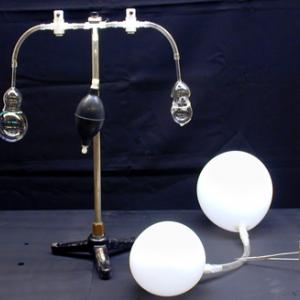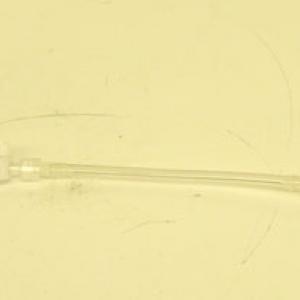College of Liberal Arts & Sciences
2A10.50 - Double Bubble Paradox
Dip the two thistle bulbs into soap bubble solution and use the bulb to blow up a small bubble on one side. Close this bubble off with a stopcock and blow a larger bubble on the other side. Open the stopcocks between the two bubbles and observe that the little one blows up the big one.
Blow up the helium balloon to a small size and attach to the Tygon tube assembly that is closed off with the hemostat. Take another helium balloon and blow it to a larger size and attach to the other end. When the hemostat is removed the small balloon should blow up the large balloon.
Attach one of the balloons over the rubber stopper, blow it up to a small size, and close off the stopcock. Attach another balloon over the other rubber stopper, blow it to a larger size, and close off the stopcock. Attach the two assemblies together with the included tubing and open the stopcocks.
For the balloon part of this demonstration to work well the volume of the larger balloon should be at least half of the balloons full size. The volume of the smaller balloon should be very much less that the larger balloon so that the rubber is not stretched very much. Should you blow the balloons to very close to the same size the demonstration will take a very long time and the probability is that the balloons will come to an equal size.
- Wojciech Dindorf, "Stable Equilibrium at the Top of a Hill", TPT, Vol. 40, #2, Feb. 2002, p. 116.
- Jack Higbie, "Cooling a Bubble by Pumping It", TPT, Vol. 35, #4, Apr. 1997, p. 241.
- Charles Waiveris, "Soap Bubbles on a Cold Day", TPT, Vol. 32, #7, Oct. 1994, p. 404.
- Ernest K. Chapin, "The Strange World of Surface Film", TPT, Vol. 4, #6, Sept. 1966, p. 271.
- David P. Jackson and Sarah Sleyman, "Erratum: “Analysis of a deflating soap bubble” [Am. J. Phys. 78 (10), 990–994 (2010)]", AJP, Vol. 79, #3, Mar. 2011, p. 333.
- David P. Jackson and Sarah Sleyman, "Analysis of a Deflating Soap Bubble", AJP, Vol. 78, #10, Oct. 2010, p. 990.
- F. L. Román, J. Faro, and S. Velasco, "A Simple Experiment For Measuring The Surface Tension Of Soap Solutions", AJP, Vol. 69, #8, Aug. 2001, p. 920.
- F. Weinhaus and W. Barker, "On the Equilibrium States of Interconnected Bubbles or Balloons", AJP, Vol. 46, #10, Oct. 1978, p. 978.
- Tik L. Liem, "Which Bubble is Stronger?", Invitations to Science Inquiry, Second Edition, p. 118.
- Vicki Cobb and Kathy Darling, "The Odds Against Blowing Up", Bet You Can't!, p. 54.
- Jearl Walker, "4.70. Inflating Bubbles and Balloons", The Flying Circus of Physics Ed. 2, p. 207.
- Harvard Instructional Physics Labs, "Pressure and Surface Tension", www.fas.harvard.edu/~scphys
- Robert L. Wild, "Pressure in Soap Bubbles", Low-Cost Physics Demonstrations, #82, p. 51.
- Christopher P. Jargodzki and Franklin Potter, "101, Double Bubble", Mad About Physics, p. 36, 181.
- Janice VanCleave, "Which Way", Physics for Every Kid - 101 Easy Experiments in Motion, Heat, Light, Machines, and Sound, p. 172 - 173.
- Julius Sumner Miller, "Cenco-Miller Double Bubble Paradox", Physics Fun and Demonstrations, p. 168 - 169.
- Bobby Mercer, "Double Trouble", Junk Drawer Physics, p. 181.
- Tik L. Liem, "The Strong Soap Film", Invitations to Science Inquiry - Supplement to 1st and 2nd Ed. p. 45.
- Julius Sumner Miller, Q80 & A80, Millergrams I – Some Enchanting Questions for Enquiring Minds, p. 52 & 104.
Disclaimer: These demonstrations are provided only for illustrative use by persons affiliated with The University of Iowa and only under the direction of a trained instructor or physicist. The University of Iowa is not responsible for demonstrations performed by those using their own equipment or who choose to use this reference material for their own purpose. The demonstrations included here are within the public domain and can be found in materials contained in libraries, bookstores, and through electronic sources. Performing all or any portion of any of these demonstrations, with or without revisions not depicted here entails inherent risks. These risks include, without limitation, bodily injury (and possibly death), including risks to health that may be temporary or permanent and that may exacerbate a pre-existing medical condition; and property loss or damage. Anyone performing any part of these demonstrations, even with revisions, knowingly and voluntarily assumes all risks associated with them.

